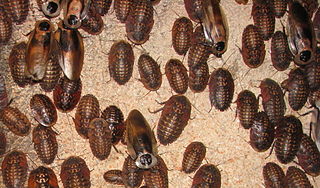
Giant cockroaches, or blaberids, are the second-largest cockroach family by number of species. Mostly distributed in warmer climates worldwide, this family is based on the American genus Blaberus, but much of the diversity is also found in Africa and Asia.
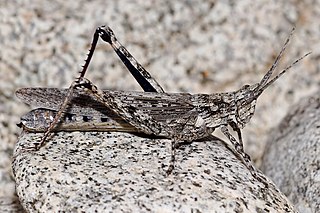
Acrididae, commonly called short-horned grasshoppers, are the predominant family of grasshoppers, comprising some 10,000 of the 11,000 species of the entire suborder Caelifera. The Acrididae are best known because all locusts are of the Acrididae. The subfamily Oedipodinae is sometimes classified as a distinct family Oedipodidae in the superfamily Acridoidea. Acrididae grasshoppers are characterized by relatively short and stout antennae, and tympana on the side of the first abdominal segment.
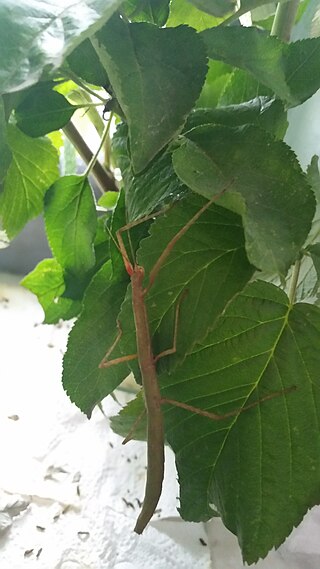
Carausius is a genus of the tribe Lonchodini, in the order Phasmatodea. The genus is in many ways typical of the Phasmatodea in that all species are twig-like in appearance. These species are parthenogenetic.

The Euphasmatodea, also known by its junior synonym Verophasmatodea is a suborder of the Phasmatodea, which contains the vast majority of the extant species of stick and leaf insects, excluding the Timematodea. The oldest record of Euphasmatodea is Araripephasma from the Crato Formation of Brazil, dating to the Aptian stage of the Early Cretaceous.
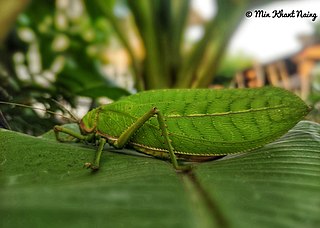
The subfamily Pseudophyllinae contains numerous species in the family Tettigoniidae, the katydids or bush crickets. Sometimes called "true katydids", together with the crickets of suborder Ensifera, they form part of the insect order Orthoptera which also contains grasshoppers.

The Phaneropterinae, the sickle-bearing bush crickets or leaf katydids, are a subfamily of insects within the family Tettigoniidae. Nearly 2,060 species in 85 genera throughout the world are known. They are also known as false katydids or round-headed katydids.

Ramulus is an Asian genus of stick insects in the family Phasmatidae and tribe Clitumnini.

Bacillidae is a stick insect family in the order Phasmatodea and the suborder Verophasmatodea.
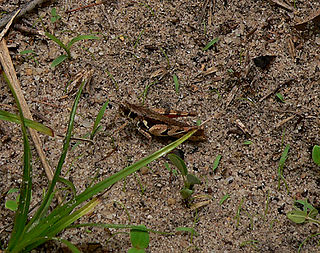
Catantopini is a tribe in the subfamily Catantopinae, a group of grasshoppers found in Africa, Asia and Australia.

The Clitumninae are a sub-family of stick insects in the family Phasmatidae found in Asia. The type genus Clitumnus is now considered a synonym of Ramulus.

Phlaeoba is a genus of grasshoppers in the family Acrididae and subfamily Acridinae. The recorded distribution of species includes: India, China, Indo-China and Malesia.

The Phlaeobini are a tribe of grasshoppers in the subfamily Acridinae. The recorded distribution of genera includes: Africa, the Middle East and Asia.

Lonchodidae is a family of stick insects, with more than 150 genera and 1,000 described species.
Lissotrachelus is an Asian genus of crickets, typical of the tribe Lissotrachelini; species records range from southern China, Indo-China to Borneo.

The Platycraninae are an anareolate subfamily of stick insects in the family Phasmatidae. Their known distribution includes southern, southeast Asia and Australasia.
Pachymorpha is a genus of phasmids belonging to the family Diapheromeridae.
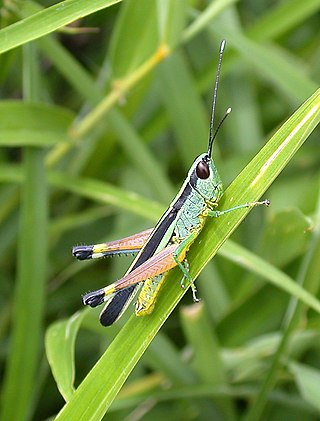
Ceracris fasciata is a species of band-winged grasshopper in the family Acrididae. It is found in Indomalaya.

Phlaeoba infumata is a species of short-horned grasshopper in the family Acrididae. It is found in Indomalaya.
Rhamphophasma is a genus of stick insects in the tribe Clitumnini, erected by Carl Brunner von Wattenwyl in 1893. Species have been recorded from: China, Vietnam, India, Myanmar and Japan.

Parapachymorpha is a genus of stick insects in the tribe Medaurini, erected by Carl Brunner von Wattenwyl in 1893. Species have been recorded from: China, Myanmar, Thailand, Cambodia and Vietnam.

















